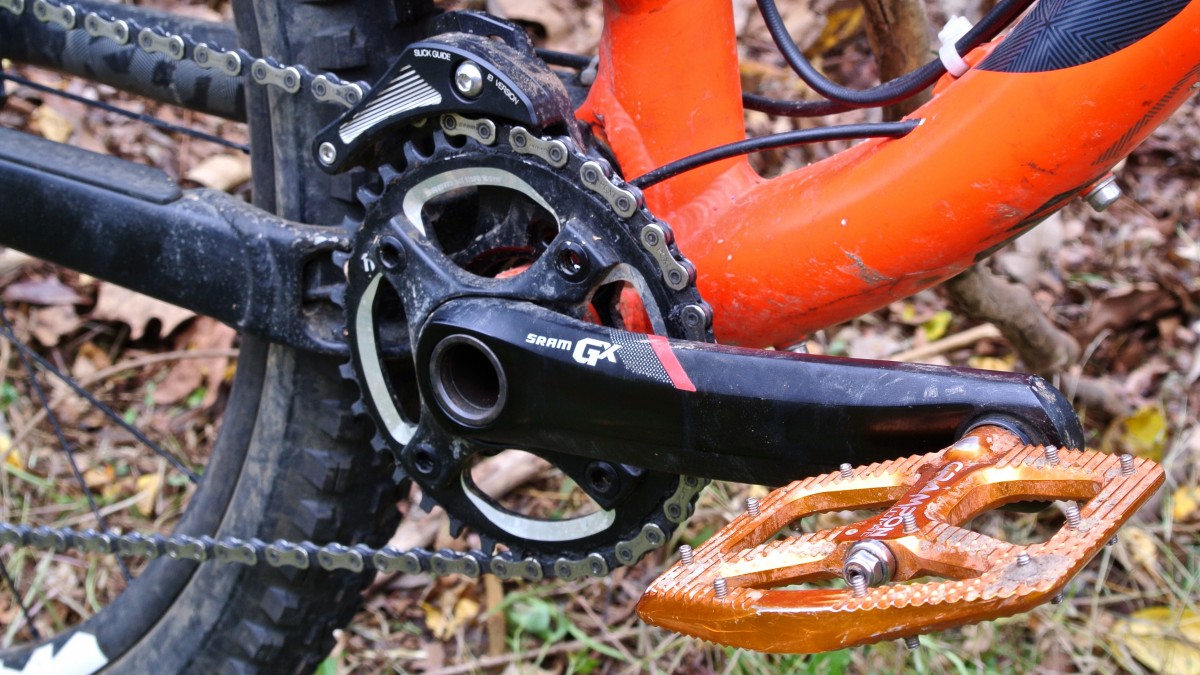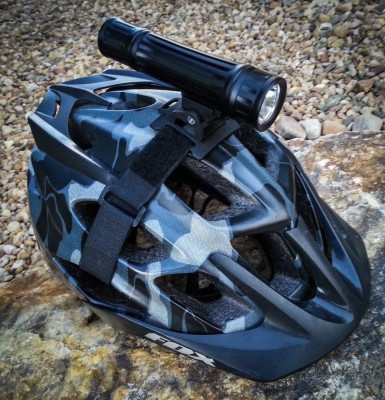
Arguably one of the most revolutionary mountain bike products of the past few years is SRAM’s XX1 group. While it initially seemed to be aimed at XC racers, it quickly found its way to trail bikes. Apart from being simple and light, ditching the front derailleur opened up new possibilities in frame design. It allowed tire clearance to improve and chain stays to shorten. And with the large 42T cog on the cassette, you could still pedal up the steepest grades. The group also spawned an entire sub-industry for wide range 10-speed hacks. Just think of all the companies out there making 40T and 42T cogs: OneUp, Hope, Wolf Tooth, e.thirteen, and Absolute Black, just to name a few.
The only drawback? The cost. At around $1,500 for the group, for many it was a lust-worthy, but unattainable upgrade. There was also the issue of needing an XD driver body to fit SRAM’s proprietary cassette design. While many hubs were adaptable to the new format, some weren’t, which meant needing to buy a new rear wheel as well.
Over the next couple seasons, SRAM released more affordable groups. First there was X01 and then X1. At around $1,300 and $900, respectively, they went a long way towards bringing 11-speed to the masses. Now, with the launch of the GX group, SRAM has gotten the price down to an impressively-low $560. So, how does a sub-$600 11-speed group fare? I’ve spent the past several months riding it to find out.
Specs
At a quick glance, you’d be hard-pressed to tell GX apart from its more expensive siblings. The overall aesthetics across all of the groups is very similar, particularly with respect to the rear derailleurs. The real differences between the groups lie in the minute details, many of which aren’t outwardly noticeable. You won’t see carbon fiber or ceramic bearings on the GX stuff. Even so, less than 300g (10.6oz) separate GX from the top shelf XX1 group. Much of that discrepancy can be chalked up to the cranks and the cassette.

Actual Weights
- Shifter (w/ cable): 4.3 oz // 122g (122g claimed)
- BB: 3.1 oz // 88g
- Derailleur: 9.2 oz // 261g (265g claimed)
- Cranks (w/ 34T ring): 1lb 8.2oz // 686g (680g claimed w/ 32T ring)
- Cassette: 11.4oz // 323g (325g claimed)
- Chain (whole): 9.4oz // 266g (258g claimed)
- TOTAL: 3.85lb // 1,746g
Based on my research, the 1×11 GX group is over 120g (4.2oz) lighter than Shimano’s new M8000 series XT group. Both groups can be had for roughly the same amount of money, so personal preference is likely going to be the major factor when choosing one over the other.
Installation
For the duration of the test, I had the GX group mounted up to my personal bike, a Kona Process 153. Putting the group on was as straightforward as any other. Getting the cable fed through the jockey wheel on the rear derailleur took a little extra care, and it seemed like I was tightening the cassette to the driver forever, but otherwise, no issues.
As with the move from 9-speed to 10-speed, it did seem like tuning the 11-speed derailleur did take a bit longer and was more finicky. When the chain is in the small, 10T cog, it is very close to the dropout/chain stay on my frame. Getting the limit screw set was key to prevent it from rubbing. Depending on the design of your own bike, you may have more breathing room. However, once I had the cable tension, b-tension screw, and limit screws set properly, the chain moved happily up and down the cassette for the entire test.
Riding
Lever throw on the shifter is short and the shifts are quick and crisp. It takes only a light touch to shift into an easier gear. There is a satisfying “click” going into every gear, except the biggest, 42T cog. The derailleur would shift into that gear just fine, it just didn’t provide any audible feedback. Like SRAM’s other shifters, you can grab several easier gears with just one long press of the thumb. You can get from the hardest to easiest gear rapidly, and the rear derailleur always complied. Going from easy to hard, you’re only allowed one gear at a time. However, I’ve never found this to be an issue as a large part of my childhood was spent with a Nintendo controller in my hand, rapidly pressing buttons. As fast as you can click, the gears come.

One thing that Shimano shifters have that SRAM does not, is the dual release action. With Shimano, you can use either your thumb or index finger to click into a harder gear, but SRAM is thumb only. When riding with a Shimano drivetrain, I find myself alternating between shifting methods, and it’s always a bit of an adjustment going to SRAM.
Over the course of the test, I shifted like an idiot just to see if I could trip up the drivetrain. It didn’t always sounds pretty, but the derailleur would eventually agree to my spastic demands. At the start of the test, I wasn’t using any kind of chain guide, and chain retention was excellent as we’ve come to expect from SRAM’s X-Sync rings. Eventually, I did add a small upper guide from Hope, just for an extra bit of security.

I was able to throw the chain over the top of the cassette during an unfortunate encounter with a stick during a climb. That was a freak occurrence, though, and it wasn’t the fault of the drivetrain. While on the topic of durability, I’ve been impressed. The derailleur took the brunt of that encounter with the stick and shrugged it off. I did have to replace the shifter after my friend crashed while riding my bike. The larger thumb lever was badly bent, but it got him through the rest of the ride. When I tried to bend it back, the lever snapped off. That’s aluminum for ya! Luckily, the shifters are reasonably priced at $55 MSRP, but can be found for under $40.
I’ve been testing another bike with Shimano’s 11-speed XT group and it has a very annoying quirk to it. While back-pedaling in the easiest gear, the chain will drop down the cassette. I’m happy to report I haven’t had this issue with SRAM’s GX drivetrain.
Final Thoughts
Inevitably, someone will comment that, “almost $600 for a drivetrain is NOT affordable, you elitist assholes!” but that’s par for the course. I think the asking price is entirely reasonable given the level of performance the GX group provides. In fact, I’d go a step further and say it’s a steal at that price. If the weight is too high for your tastes, you could get creative with some mix-and-match action from SRAM’s higher end 11-speed groups. Personally, my best-bang-for-the-buck choices would be: GX shifter; GX rear derailleur; XX1 crankset; and X01 cassette. That combo would save about half a pound over an all GX group.

Probably the most exciting thing to me about SRAM releasing GX is the implications it has for complete bikes. It suddenly just got a whole lot cheaper for bike manufacturers to spec a 1×11 drivetrain. We’ve already seen GX spec’d on numerous 2016 bikes, and we’ll only see more of it–and I think that’s a good thing. Getting a quality drivetrain at an affordable price means there’s more money left over for other components–such as suspension and wheels–that are arguably more vital to the overall ride experience.
We say it a lot, but right now is a really good time to be a mountain biker. SRAM’s excellent GX drivetrain is just further proof for that claim.
Thanks to SRAM for providing the GX group for review.











5 Comments
Dec 10, 2015
Just one minor issue, not knowing you as well as I do some of the other rider/journos I follow (noticabley the inspirationalRichard Kelly of IMB) it might be useful if your 'profile' had a little more info re where you ride, based on the Kona one assumes not long distance XC?. This is crucial info with regard to the decision making process when one comes to following up reviews/recommendations re kit purchase.. also how far, fast, high you ride..I might add I'm thinking of insisting that all MTB journos post ALL their rides publically on STRAVA for more accurate comparisons ;).
Finally just how much 'care' did you take of the kit?
.....................
and don't let any of this reply detract from a reet grand read as we say up here in the northern reaches..
Dec 10, 2015
I enjoy all types of riding: XC, trail, DH, road, cyclocross, etc. My preferred rides are all-day affairs with plenty of climbing, and therefore, plenty of descending. I'm a firm believer in earning my turns.
The Kona is not light, but it pedals well for what it is and I've taken it on some long rides. Probably the burliest single ride I did on it during the test was 32 miles with 6,000+ ft. of climbing.
As for taking care of the kit, apart from keeping the chain clean and lubed, I didn't have to do much else. Due to the design, the pulleys on the derailleur do attract a fair amount of grime. They required cleaning more frequently than pulleys without cutouts. Besides that, nothing. And that wasn't due to neglect, it was because the group just works.
Feb 13, 2017
That's $369 on Amazon from the official SRAM dealer. And if you buy the parts individually, switch it out for a Sunrace Cassette, get the SRAM GX1000 crankset, you can get the price tag down to almost $250 for a personal build, right off of Amazon.
Feb 17, 2017
Nov 4, 2016